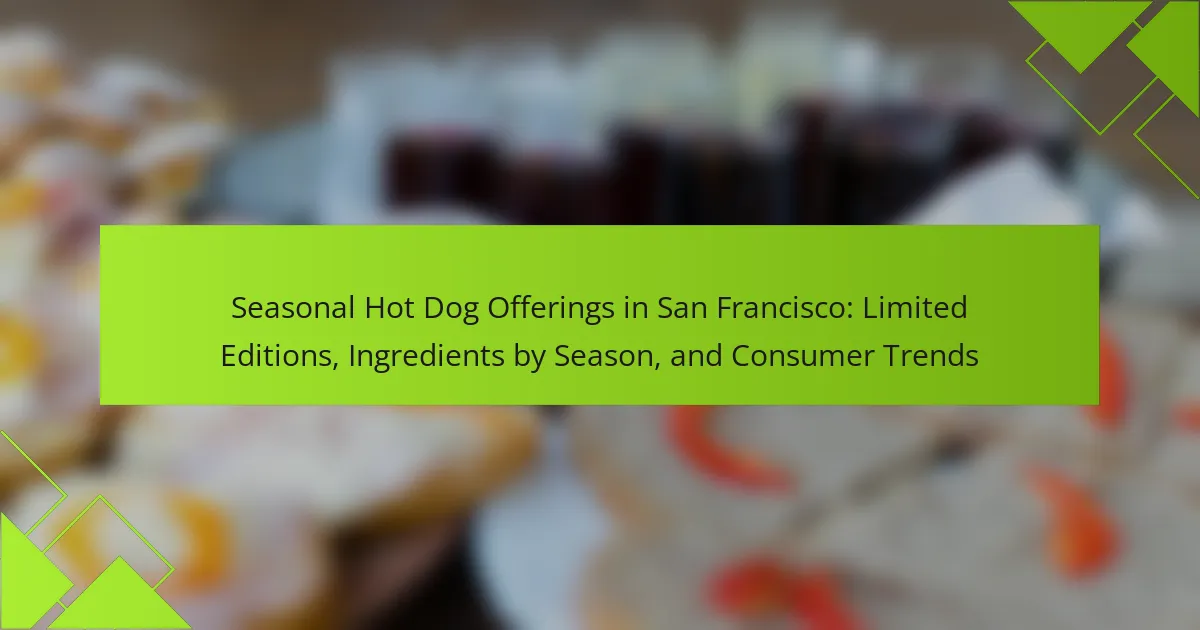Seasonal hot dog offerings in San Francisco showcase a variety of unique ingredients and flavors that change throughout the year. Summer features fresh toppings such as heirloom tomatoes and basil pesto, while fall introduces pumpkin spice-infused sausages and apple chutney. Winter specials include spicy chili dogs and toppings like sauerkraut and mustard, and spring brings lighter options with avocado and citrus salsa. These seasonal variations reflect local consumer trends and highlight the use of fresh, seasonal produce available in the region.

What are Seasonal Hot Dog Offerings in San Francisco?
Seasonal hot dog offerings in San Francisco vary throughout the year, featuring unique ingredients and flavors. In the summer, vendors often introduce fresh toppings like heirloom tomatoes and basil pesto. Fall offerings may include pumpkin spice-infused sausages or apple chutney as a topping. Winter specials can feature spicy chili dogs or hot dogs topped with sauerkraut and mustard. Spring often brings lighter options, such as hot dogs topped with avocado and citrus salsa. These seasonal variations cater to local tastes and highlight fresh, seasonal produce available in San Francisco.
How do seasonal hot dog offerings differ from regular options?
Seasonal hot dog offerings differ from regular options primarily in their ingredients and flavor profiles. Seasonal options often incorporate fresh, locally sourced produce that reflects the time of year. For example, summer offerings may include toppings like fresh tomatoes and basil, while winter varieties might feature hearty ingredients like sauerkraut and roasted vegetables.
Additionally, seasonal hot dogs frequently showcase unique flavor combinations that are not typically found in regular options. These can include specialty sauces or regional spices that align with seasonal festivities or themes.
The limited availability of these seasonal offerings creates a sense of urgency and exclusivity, enticing consumers to try them before they are gone. This strategy is supported by consumer trends indicating a growing interest in seasonal and artisanal food experiences.
What factors influence the creation of limited edition hot dogs?
The creation of limited edition hot dogs is influenced by seasonal ingredients, consumer trends, and culinary creativity. Seasonal ingredients dictate what flavors and components are available at different times of the year. For example, summer may feature fresh vegetables and herbs, while winter could emphasize hearty spices and toppings. Consumer trends impact the popularity of certain flavors or dietary preferences, such as plant-based options or gourmet toppings. Culinary creativity allows chefs to experiment with unique combinations and presentations, making limited editions appealing. Additionally, marketing strategies play a role in promoting these offerings to attract customers. These factors collectively shape the development and success of limited edition hot dogs in the market.
How do local events impact seasonal hot dog offerings?
Local events significantly influence seasonal hot dog offerings. Vendors often create special recipes to align with event themes. For example, during the San Francisco Pride Parade, hot dogs may feature rainbow toppings. Events like the San Francisco Giants games lead to baseball-themed hot dogs, incorporating local flavors. Seasonal festivals introduce unique ingredients, such as pumpkin spice hot dogs in fall. Consumer preferences shift during events, prompting vendors to adapt their menus. Research indicates that localized offerings can increase sales by 30% during major events. The dynamic nature of local events fosters creativity in hot dog offerings.
What are the most popular seasonal ingredients used in San Francisco hot dogs?
The most popular seasonal ingredients used in San Francisco hot dogs include fresh vegetables and local condiments. During spring, ingredients like asparagus and artichokes are commonly featured. Summer brings ripe tomatoes and corn into the mix. In fall, seasonal flavors like pumpkin and roasted peppers become popular. Winter often sees the use of hearty greens like kale and unique toppings such as cranberry relish. These ingredients reflect the local agricultural bounty and seasonal availability. They enhance the flavor profile of hot dogs, making them more appealing to consumers. The trend aligns with the farm-to-table movement prevalent in San Francisco.
Which ingredients are typically featured in winter hot dogs?
Winter hot dogs typically feature ingredients like hearty toppings and warm spices. Common toppings include sauerkraut, caramelized onions, and chili. These ingredients provide comfort and warmth during colder months. Additionally, winter hot dogs may include seasonal ingredients such as roasted vegetables. Spices like cinnamon and nutmeg can also be incorporated for a unique flavor. These choices reflect consumer preferences for hearty, warming foods in winter. Various food vendors in San Francisco highlight these ingredients in their seasonal offerings.
How do summer ingredients enhance the flavor of hot dogs?
Summer ingredients enhance the flavor of hot dogs by introducing fresh, vibrant tastes. Ingredients like tomatoes, cucumbers, and corn provide a crisp texture and natural sweetness. Herbs such as basil and cilantro add aromatic notes that elevate the overall flavor profile. Grilled vegetables contribute a smoky depth that complements the savory taste of hot dogs. Additionally, summer condiments like salsa or tangy barbecue sauce offer zesty contrasts. These seasonal ingredients create a balance of flavors, making hot dogs more appealing during summer gatherings. The use of fresh produce is shown to increase consumer satisfaction, as reported in culinary studies on seasonal eating.
What consumer trends are influencing seasonal hot dog offerings?
Consumer trends influencing seasonal hot dog offerings include a demand for gourmet ingredients and unique flavor combinations. Consumers increasingly seek locally sourced and sustainable products. There is also a growing interest in plant-based options, reflecting a shift towards healthier eating habits. Seasonal flavors, such as those inspired by local festivals or holidays, are gaining popularity. Additionally, customization and personalization of hot dogs are trending, allowing consumers to tailor their meals. According to market research, 60% of consumers prefer unique and innovative food experiences. This data supports the shift towards diverse and creative hot dog offerings.
How are dietary preferences shaping limited edition hot dogs?
Dietary preferences are significantly shaping limited edition hot dogs by influencing ingredient choices and flavor profiles. Many consumers are now seeking plant-based options due to vegetarian and vegan trends. This shift has led brands to develop hot dogs made from ingredients like pea protein and quinoa.
Additionally, health-conscious consumers prefer lower sodium and nitrate-free options. This demand has prompted manufacturers to create gourmet hot dogs that feature organic meats and natural spices. Seasonal ingredients also play a role, with local produce being incorporated into limited editions, reflecting regional tastes.
Research indicates that 39% of consumers are actively reducing meat consumption, impacting product development in the hot dog market. This trend has resulted in innovative flavor combinations that appeal to diverse dietary needs. Limited edition hot dogs are now often marketed as unique culinary experiences, catering to evolving consumer preferences.
What role does social media play in promoting seasonal hot dog trends?
Social media plays a critical role in promoting seasonal hot dog trends. It serves as a platform for brands to showcase limited edition offerings. Visual content, such as photos and videos, captures consumer attention effectively. Hashtags related to seasonal hot dogs increase visibility and engagement. User-generated content amplifies brand reach when customers share their experiences. Seasonal promotions often trend on platforms like Instagram and TikTok. This engagement can lead to increased foot traffic at local vendors. Research indicates that 70% of consumers are influenced by social media in their food choices.
How do seasonal hot dog offerings connect with local culture?
Seasonal hot dog offerings connect with local culture by incorporating regional ingredients and flavors. These offerings often reflect the culinary traditions and preferences of the area. For instance, in San Francisco, hot dogs may feature locally sourced produce or seafood, aligning with the city’s emphasis on fresh, sustainable food. Seasonal events, such as festivals or holidays, inspire unique hot dog creations that celebrate local customs. This practice fosters community engagement and pride. Additionally, local vendors often collaborate with nearby breweries or farms, enhancing the cultural connection. These collaborations highlight the importance of supporting local businesses and artisans. Overall, seasonal hot dog offerings serve as a delicious representation of San Francisco’s diverse food culture.
What are the key selling points for seasonal hot dogs in San Francisco?
Seasonal hot dogs in San Francisco are popular due to unique flavor profiles and local ingredients. These hot dogs often feature seasonal toppings that reflect the city’s culinary trends. For example, summer offerings may include fresh tomatoes and herbs. In contrast, winter options might incorporate hearty ingredients like roasted vegetables or spicy sauces.
Limited editions create excitement among consumers. They encourage repeat visits and word-of-mouth promotion. Seasonal hot dogs also cater to local food trends, such as sustainability and organic sourcing. Many vendors highlight their use of locally sourced meats and produce. This aligns with the city’s focus on farm-to-table dining experiences.
Additionally, seasonal hot dogs often embrace cultural influences. This variety attracts diverse consumer segments. Festivals and events in San Francisco further enhance visibility and sales. Seasonal hot dogs can also be paired with local craft beers, enhancing the overall dining experience.
How can vendors effectively market their seasonal hot dog offerings?
Vendors can effectively market their seasonal hot dog offerings by leveraging local ingredients and seasonal themes. Highlighting unique flavors tied to local events can attract customers. For example, a summer barbecue hot dog can feature grilled corn and chipotle sauce. Utilizing social media platforms to showcase these limited-time offerings builds excitement and urgency. Engaging with local influencers can enhance visibility and credibility. Seasonal promotions, such as discounts during festivals, can drive foot traffic. Providing samples at local events allows potential customers to taste before buying. Research shows that experiential marketing boosts customer engagement. According to a 2022 study by the National Hot Dog and Sausage Council, themed promotions increase sales by 20% during peak seasons.
What best practices should vendors follow for seasonal hot dog promotions?
Vendors should leverage seasonal ingredients and themes for hot dog promotions. Using locally sourced produce enhances flavor and supports local farmers. Create limited-time offers to generate urgency among customers. Promote these items through social media to reach a wider audience. Engaging visuals and appealing descriptions can attract more customers. Offering samples can encourage trial and increase sales. Collaborating with local events can enhance visibility and draw in crowds. Tracking sales data during promotions helps refine future strategies.
Seasonal hot dog offerings in San Francisco represent a dynamic culinary trend that incorporates unique ingredients and flavors throughout the year. This article explores how these limited edition hot dogs differ from regular options, highlighting the influence of seasonal ingredients, local events, and consumer trends on their creation. Key factors such as dietary preferences, social media promotion, and cultural connections are examined, along with best practices for vendors to market their seasonal products effectively. The discussion emphasizes the appeal of seasonal hot dogs, showcasing their alignment with local tastes and the farm-to-table movement.
